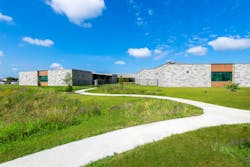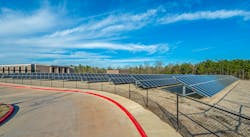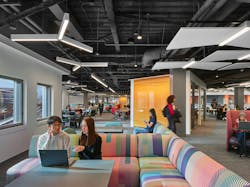Schools and universities have been making efforts for a long time to incorporate sustainability into the design and operations of their facilities. Numerous strategies have been adopted to design and construct spaces that expend energy more efficiently, conserve water, reduce waste, use a smaller carbon footprint, and provide a healthful learning environment for students.
Much progress has been made in making education facilities more energy efficient and environmentally friendly. But, as scientists issue more urgent warnings about the negative effects of global warming and climate change, the cry has grown louder for schools and universities to emphasize sustainability in their buildings and on their campuses.
With tens of thousands of K-12 and higher education facilities across the nation, many opportunities remain for the sustainability movement to make greater strides in education.
Cost concerns
As is the case with many of the goals that schools and universities pursue, a gap exists between what is theoretically possible and what is feasible given the financial limits that constrain most education institutions. Lack of money puts many initiatives at schools and universities on the back burner.
“It really comes down to construction costs and budgets,” says Ryan Gregory, managing partner of the PBK architecture firm. “With the increase in construction costs that we’ve seen across the board, it makes it that much more challenging from both a design standpoint and an owner standpoint to implement what I will call more progressive sustainable technologies.”
The green movement has progressed to the point where most states have enacted regulations and codes that set certain requirements for sustainability and green design, Gregory says. Many education institutions embrace sustainability to meet those standards, but budget constraints persuade them not to go beyond that.
“With the high construction costs and everything else, our clients are defaulting to just going with standard state code to achieve to achieve that level of green design or sustainability,” Gregory says.
Gregory adds that he won’t necessarily try to persuade reluctant school administrators to pursue specific strategies to enhance sustainability, but he makes sure they have the information needed to make an informed decision.
“As far as what research is uncovering, as a company, we make it a practice—almost like a moral obligation—to share information,” Gregory says. “We are completely transparent with everything that comes with it, including the costs, but as a practice, we think we are obligated to share research that is evidence-based.
"Because of budgeting, state mandated codes and regulations and because of some clients’ tendencies to want to just meet the bare minimum, we're finding it more important to just educate them on the technologies, the applications that we know research supports. And we have found that when we do share that research, sometimes it opens the eyes of some of our clients.”
Daylighting
One of the sustainability strategies that schools have widely embraced in the last 20 years is daylighting.
“The incorporation of natural light into spaces continues to be popular,” Gregory says. “There’s still a big push for that. There are all kinds of health benefits to natural light and everything it offers. Reducing artificial light internally continues to be a big discussion with everything we do in design.”
Those design decisions involve building orientation, placement of windows and skylights, use of low-E glazing, and making sure the daylighting techniques used are maintenance-friendly while still providing the student performance improvements that effective daylighting strategies can deliver.
“It does come down to placement and orientation of the building as it relates to east, west and sun exposure,” Gregory says.
Meeting climate goals
Hundreds of universities have made a commitment to reducing their greenhouse gas emissions, and sustainably designed and built facilities provide one path to achieve those reductions. But upgrading existing facilities can be challenging if carrying out the university’s climate goals impedes the day-to-day work of faculty and students.
Steve Cunningham, director of academic for Columbia, the construction management firm, says that was the case for a sustainability project at a university’s large neuroscience facility in Massachusetts. Those working in the research labs may or may not have been supporters of sustainability and the university’s climate goals, but they were definitely unhappy about the disruption to their workspace.
“We’re going into their space and impacting their work,” Cunningham says. They’re not getting more lab space; they’re not getting better equipment; they’re not getting new case work. We’ve got to make sure we communicate with them consistently throughout the project and that we’re clear about the impacts we’re going to have.”
A project that would have taken five or six month in an unoccupied building lasted 18 months because of the efforts to minimize the disruption to the researchers continuing to work in the space.
The construction team established a detailed color-coded schedule so the researchers knew what was coming .
“It's going to be a red day, so you can't be in your lab,” Cunningham says. “Here's the work we're doing, and it's going take this long. Or it's a green day, so we're going be in your space, but you should be able to still keep working, and we'll try to stay out of your way.”
Forgoing fossil fuels
One of ways for schools and universities to reduce their greenhouse gas emissions is to wean themselves off fossil fuels. They can accomplish this by converting buildings to heat and cool with electricity rather than fossil fuels, says Conor McGuire, director of sustainability at Columbia.
“There is a big push for electrification, says McGuire. “If you're electrifying the building, then you can source clean energy, whether that's with on-site solar or if that's procuring clean energy from the grid. The grid is in the process of getting cleaner nationally, and here in New England, more renewables are being added. So a building that’s all electric today will actually be cleaning five years from now, and 10 years from now.”
Aesthetic concerns
Sustainability upgrades like a solar installation may run into opposition on some campuses, especially older ones with many historic buildings.
“Some campuses don't want to even think about solar because it's going to have a big impact on the aesthetic, and aesthetic is very important in the brand universities have established for themselves,” Cunningham says. “It depends on what the aesthetic is whether those things are going to be impactful.”
McGuire adds that he wouldn't necessarily advocate for changing the aesthetic of a building, but there might be feasible alternatives.
“Maybe on the campus somewhere, there might be something like a parking garage that is not considered historical,” he says. “So there is an opportunity to put up a large array that might be a canopy over a parking lot or over a garage. It’s more palatable than (altering) a historic building.
Post-Covid
In the aftermath of the Covid-19 pandemic, many schools and universities are focusing their sustainability efforts not only on conserving resources and energy efficiency, but also on the health and safety of students, staff and others spending time in education facilities.
“Air quality has become more of a talking point for our clients,” Cunningham says. “They didn't use to think about it too much, and maybe that is an aftermath of Covid where people are more concerned about filtration of the air. As we're renovating and building, those questions come up a lot more than they did before.”
Because access to fresh air was considered critical to reducing the chances of contracting Covid-19, many schools have been making facility decisions that create outdoor spaces for students.
“There is a huge uptick in outdoor learning spaces—getting students out of the building and either expanding or adding programs where students are going outdoors to learn,” Gregory says. “A lot of parents are interested in getting their kids outside so they're not confined in a space with other people all day long. We have seen in a lot of these bond programs, more and more money is being put into outdoor spaces—everything from playground equipment to walking tracks to amphitheaters.”
Sidebar: Beyond LEED
by John Hyde
In the early days of sustainable design, the U.S. Green Building Council's LEED rating system was an overwhelming success in higher education markets by providing a framework for designing and constructing buildings through a sustainability lens. Eventually, the requirements were adopted by building codes, and manufacturers shifted toward more sustainable practices. Building projects were now "certifiable" by default.
However, academic institutions are now looking beyond LEED and broadening their sustainable focus to provide more healthful workplaces. The next generation of sustainable projects is here. And instead of building to a specific rating system, many choose to cherry-pick fundamentals from several rating systems, build the most sustainable project they can afford, and re-allocate certification costs to programming.
One of the most prominent themes on college and university campuses is decarbonization.
Here are some helpful tips to set a decarbonization plan in motion.
Perform a greenhouse gas inventory to establish a baseline operational carbon footprint and begin benchmarking progress. Consider following the Greenhouse Gas Protocol for tracking and reporting emissions because it’s the most widely recognized standard. Another acceptable standard is the U.S. Environmental Protection Agency’s Scope 1, 2, and 3 guidelines.
Next, reduce energy demand by improving building enclosures. Look for opportunities to upgrade the enclosure when performing renovations. Air sealing and insulation alone can result in long-term savings and improve occupant comfort. Retro-commissioning HVAC equipment will optimize system performance, lower the operating budget, and reduce carbon emissions.
Third, eliminate dependence on fossil fuels and electrify buildings. Electrification is a viable option for new construction and renovations. Develop a comprehensive electrification plan, taking into consideration phasing requirements and impacts on ongoing operations.
Finally, deploy renewable energy strategies when feasible. Solar panels are economical and can be installed on buildings or ground mount structures. Many higher education facilities are exploring ground source heat pump systems. Geothermal systems can be networked to condition multiple buildings.
Academic facility managers need to effectively communicate the plan to everyone who might have a part in its success. Colleges and universities must work together with construction and design partners to mitigate climate change and preserve the planet.
John Hyde is Senior Sustainability Manager for Chapman Construction/Design
About the Author
Mike Kennedy
Senior Editor
Mike Kennedy has been writing about education for American School & University since 1999. He also has reported on schools and other topics for The Chicago Tribune, The Kansas City Star, The Kansas City Times and City News Bureau of Chicago. He is a graduate of Michigan State University.



